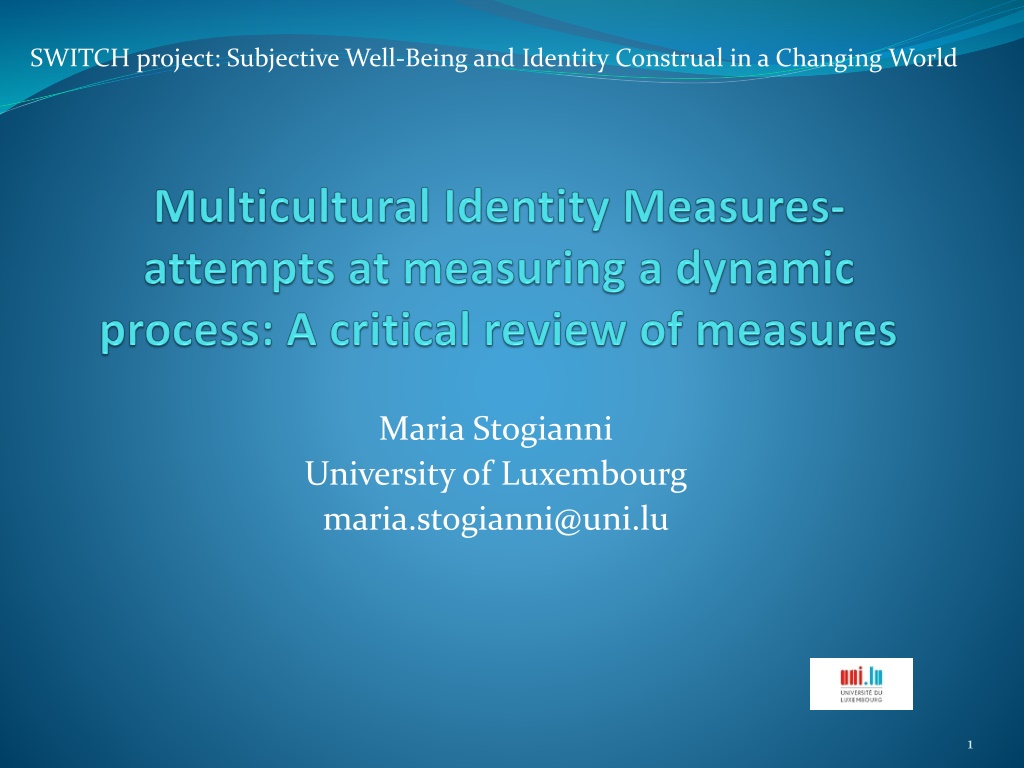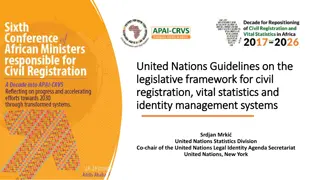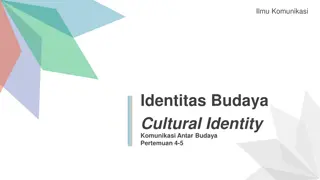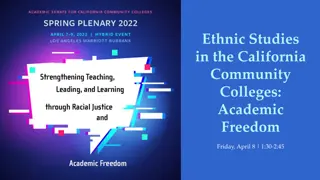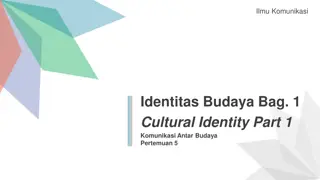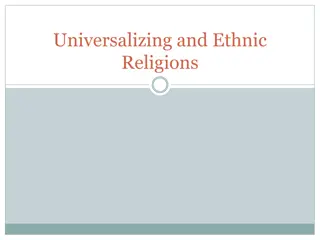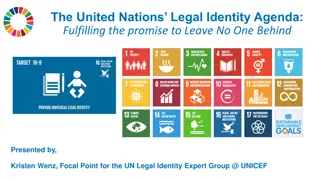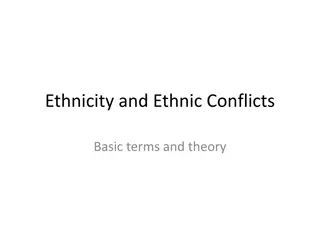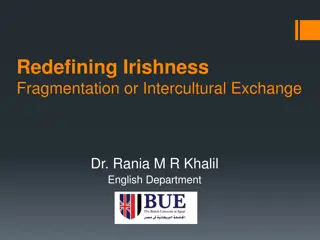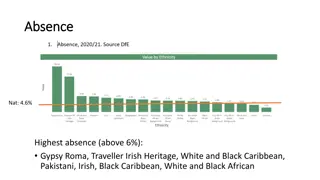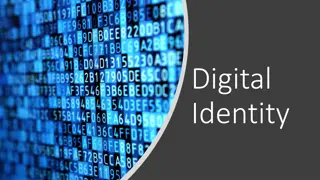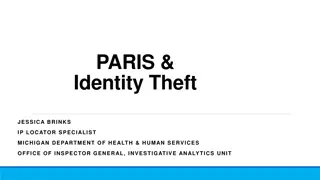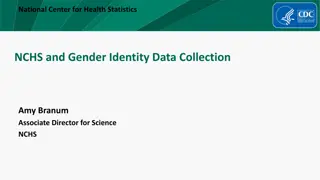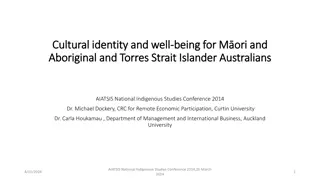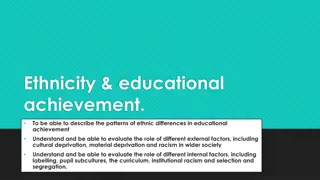Understanding Ethnic Identity Development in a Changing World
Experiences of migration, participation in diverse social networks, and the use of online platforms influence identity development in multicultural contexts. The study explores identity measures, challenges, and future research suggestions, emphasizing the fluidity of cultural identities and the importance of exploring multiple cultural streams.
Download Presentation

Please find below an Image/Link to download the presentation.
The content on the website is provided AS IS for your information and personal use only. It may not be sold, licensed, or shared on other websites without obtaining consent from the author. Download presentation by click this link. If you encounter any issues during the download, it is possible that the publisher has removed the file from their server.
E N D
Presentation Transcript
SWITCH project: Subjective Well-Being and Identity Construal in a Changing World Maria Stogianni University of Luxembourg maria.stogianni@uni.lu 1
Background Ethnic Identity Measures Measuresand assessment methodsof biculturalism Limitations Multicultural/Cosmopolitan Identity Measures Summary Suggestions for future research 2
Background Experiences of migration, participation in culturally diverse social networks and the use of web based communication platforms influence the process of identity development. The contexts of migration have changed, affecting the ways in which individuals negotiate their multiple cultural identities. It is possible that they endorse two or more cultural streams or develop contextually dependent identities (Chryssochoou, 2000). As a result, they might identify with different cultural groups in different life domains (Schwartz, Birman, Benet-Mart nez, & Unger, 2017). 3
Background Initial approaches in the studyof identitydevelopment under thecontext of migration reflected an essentialist view of identity: one s heritageand receiving cultural streams are fixed (Schwartz et al., 2017) Ethnic and national identities appeared to be oppositional Identity measures and the majority of research in this area focused on one minoritygroup living in one majority culture (i.e. Mexican-Americans) 4
Overview of Identity Measures in Cross-Cultural Research Self-report Questionnaires Pictorial Measures of Identity Fusion Implicit Measures Interviews, narratives Mixed Methods 5
Multigroup Ethnic Identity Measure (Phinney, 1992) Self-reportquestionnaire thatassesses the process of ethnic identitydevelopment in young adolescentsand adults (12 items) Cronbach s Alpha above .80 across a wide range of samples I feel a strong attachment towards my own ethnic group 1 2 Strongly Disagree Neutral Agree Strongly disagree agree 3 4 5 6
Multigroup Ethnic Identity Measure (Phinney, 1992) 2 subscales: Ethnic Identity Exploration (5 items): investigating and learning more about the meaning of one s ethnic background (developmental and cognitive component) I have spent time trying to find out more about my ethnic group, such as its history, traditions, and customs Ethnic Identity Commitmnet (7 items): belongingness to one s ethnic group and behaviors associated with group membership (affectiveattitudinal component) I have a clear sense of my ethnic background and what it means for me Scoring A mean score forthe 12 items: higherscores indicate strongerethnic group identification 7
Open-ended self descriptions The 20 statements test (Kuhn & McPartland, 1954) Who am I? 1. 2. 3. 8
Pictorial Measures of Identity Fusion (Swann et al., 2009) Pictures that represent different degrees of overlap between the self and a cultural group. Participants are asked which representation captures best their relationship with the group. 9
Measures and Assessment Methods of Biculturalism-Multiculturalism Systematic Review -Database Search (PubMed, PsycINFO, PsycARTICLES) -Key words: assessment, biculturalism, bicultural identity, multiculturalism, multicultural identity, cosmopolitanism -Inclusion criteria: -Papers published between 2000-2017 in peer-reviewed journals, as book chapters, or dissertations -Assessment of Bicultural/Multicultural Identity using quantitative research methods -Availability of instruments 10
Measures and Assessment Methods of Biculturalism Assessments of biculturalism initially relied on traditional acculturation measures. Biculturalism = Integration acculturation strategy Bipolar, single dimension scales. Middle scores reflect biculturalism Bidimensional scales, involvementwith heritageand hostcultureare assessed with twoseparate scales Difference scores Cut-off points: differentiate bicultural individuals from thosewith differentacculturationstrategies Scores on the twocultural orientationscombined intoan interaction term (Birman, 1998) Scales that provide separate response categories for each acculturation orientation (i.e. 1 = the US, 2 = the country of origin, 3 = both, 4 = neither ) 1. 2. 3. 11
Measures and Assessment Methods of Biculturalism Limitations Unidimensional scales as well as difference scores confound biculturalism with marginalisation The useof median or scalarsplit approaches inflates the numberof peoplewho fall into integration orientation Cut-off points: difficult to differentiate between those who have medium scores on both scales and those who score very high on one scale and low on the other Reliability issues 1. 2. 3. 4. 12
Measures and Assessment Methods of Biculturalism How do people with different ethnic backgrounds internalize cultures? Objectives: Assess individual differences in the way bicultural individuals negotiate their dual cultural identities Capture the diverse experiencesof bicultural individuals Investigateaffective, cognitive and behavioral consequences of biculturalism Investigate underwhich conditions individuals experience conflict or integrationof theirdual cultural identities 13
Bicultural Identity Integration Scale (Huynh, Nguyen, & Benet- Martinez, 2009) Measures perceptions of managing dual cultural identities (items) Bicultural Identity Integration: an individual differencevariable 2 orthogonal dimensions: Cultural conflict vs. harmony between the 2 cultural identities, = .74 Affectivecomponent I feel __________ and American at the same time Cultural distance vs. blendedness, = .79 Cognitivecomponent I feel that my __________ and American cultures are incompatible 14
Bicultural Identity Orientation Scale-BIOS (Comanaru, 2009) Developed to explore different dimensions of bicultural identification (19 items) 5 subscales: Monocultural orientation: desire to belong only to one culture, = .85 I feel it is easier to belong just to one culture . Flexibility: behavioral switching depending on the context, = .86 My cultural identity varies depending on whom I am with Compatibility: perceived congruence between the 2 cultures, = .90 My ethnic culture is compatible with the Canadian culture Conflict, = .86 There is a conflict within myself between the two cultures I belong to Hybridity: blend of the 2 cultures, = .83 I feel my identity is a mix of my two cultures 15
Bicultural Self-Efficacy Scale-BSES (David, Okazaki, & Saw, 2009) A self-report instrument that assesses bicultural competence, based on La Fromboise (1993) Model (26 items) 6 dimensions: Social Groundedness: sense of belonging, ability to form stable social networks, = .91 I can develop new relationships with both mainstream Americans as well as people from the same heritage culture as myself . Communication Ability, = .79 I can communicate my ideas effectively to both mainstream Americans and people from the same heritage culture as myself . 16
Bicultural Self-Efficacy Scale-BSES (David, Okazaki, & Saw, 2009) Positive Attitudes, = .89 I have respect for both mainstream American culture and my heritage culture. Knowledge, = .80 I am knowledgeable about the history of both mainstream America and my cultural group. Role Repertoire: ability to demonstrate situationally appropriate behaviors, = .69 I can choose the degree and manner by which I affiliate with each culture . Bicultural Beliefs, = .77 It is acceptable for an individual from my heritage culture to participate in two different cultures . 17
Multicultural Identity Integration-MULTIIS (Yampolsky, Amiot, & de la Sabloniere, 2016) Assessment of different cultural identity configurations (22 items) Appropriate to assess identification with more than 2 cultural groups Scale development based on the Cognitive- Developmental Model of Social Identity (Amiot, de la Sablonni re, & Smith, 2007) Tested in culturallydiverse samples in Canada 18
Multicultural Identity Integration-MULTIIS (Yampolsky, Amiot, & de la Sabloniere, 2016) 3 dimensions: Categorization, = .58 One cultural identity predominates in how I define myself Compartmentalization, = .66 Each of my cultural identities reflects a separate part of who I am Integration, = .87 My cultural identities complement each other 19
Implicit Measures Implicit Association Task (Devos, 2006) American Culture Mexican Culture Me Them Image result for american pictures 20
Implicit Measures Behavioral measure based on reaction times. Assesses the strength of association between two concepts. If someone finds iteasier to combine self-related words with pictures that represent one cultureoveranother (shorter reaction times) this is an indication of strong identification with this culture It is also possible to investigate the strength of identification with the mainstream culture and the culture of origin relative to one another and relative to a less relevant point of reference (other cultures) 21
Multiculturalism Globalization-based acculturation Selection of cultural elements, valuesand practices from several cultural worldviews Global Identity/Cosmopolitanism Attachment to global community, beyond one s nation 23
Multicultural Identity Measures Global Identity Scale (T rken & Rudmin, 2013) I consider myself more as a citizen of the world than a citizen of some nation Cosmopolitanism Scale (Jenning, 1967) Which one do you follow most closely international affairs, national affairs, state affairs, local affairs Universal Orientation Scale (Phillip & Ziller, 1997) At one level of thinking we are all of a kind Identification with all humanity (McFarland, Webb, & Brown, 2012) How much do you identify with (that is, feel a part of, feel love toward, have concern for) each of the following? a. People in my community b. Americans c. All humans everywhere 24
Summary Measures that assess identification with multiple cultures and individual differences in bicultural/multicultural identity integration Lack of measures in fusion models Psychometric properties have not been established for some of the existing measures Equivalent versions in different languages Measures that are appropriate fordifferentage groups (i.e. adolescents) 25
Summary Integration and bicultural identification should be treated as differentconstructs (van de Vijver, in press) Someassessment methodsconflatedifferent dimensions of biculturalism: bicultural identification and frame switching (Schwartz et al., 2017) Most measuresdeveloped in the USA adaptions to the European context Useof situated approaches in the assessmentof cultural identification 26
Example questionnaire Example: I am happy to be a member of my ethnic/cultural group Je suis heureux(se) d tre membre du groupe ethnique auquel j appartiens Ich bin sehr froh, dass ich ein Mitglied meiner kulturellen Gruppe bin Use these numbers to answer the questions on this page: 1 2 3 almost never once in a while sometimes frequently almost always 4 5 When I am: at the school---------------------------------------1 2 3 4 5 with my family------------------------------------ 1 2 3 4 5 in my neighbourhood---------------------------- 1 2 3 4 5 with my friends----------------------------------- 1 2 3 4 5 with people form mycountryof origin--------- 1 2 3 4 5 With Luxembourgish people-------------------- 1 2 3 4 5 27
References Chryssochoou, X. (2005). Cultural diversity: Its socialpsychology. Oxford: Blackwell. David, E. J. R., Okazaki, S., & Saw, A. (2009). Bicultural self-efficacy among college students: Initial scale development and mental health correlates. Journal of Counseling Psychology, 56(2), 211-226. Huynh, Q. L., Nguyen, A. M. D., & Benet-Mart nez, V. (2011). Bicultural identity integration. In Handbook of identity theory and research (pp. 827-842). Springer New York. Kuhn, M. H., & McPartland, T. S. (1954). An empirical investigation of self attitudes. American Sociological Review, 19, 68 76. LaFromboise, T., Coleman, H. L. K., & Gerton, J. (1993). Psychological impact of biculturalism: Evidence and theory. Psychological Bulletin, 114, 395 412. Phinney, J. (1992). The Multigroup Ethnic Identity Measure: A new scale for use with adolescents and young adults from diverse groups. Journal of Adolescent Research, 7, 156-176. 29
References Schwartz, S. J., Birman, D., Benet-Mart nez, V., & Unger,J. B. (2017). Biculturalism: Negotiating multiple cultural streams. In The Oxford Handbook of Acculturation and Health, 29. New York: University Press. Swann, W. B., Jr., Gomez, A., Seyle, C. D., Morales, J. F., & Huici, C.(2009). Identity fusion: The interplay of personal and social identities in extreme group behavior. Journal of Personality and Social Psychology, 96, 995 1011. T rken, S., & Rudmin, F. W. (2013). On psychological effects of globalization: Development of a scale of global identity. Psychology & Society, 5, 63-89. Yampolsky, M. A., Amiot, C. E., & de la Sablonni re, R. (2016). The Multicultural Identity Integration Scale (MULTIIS): Developing a comprehensive measure for configuring one s multiple cultural identities within the self. Cultural Diversity and Ethnic Minority Psychology, 22(2), 166-184. Van de Vijver , F. (in press). Challenges in the study of adolescent and acculturative changes. Journal of Adolescence. Oxford 30
